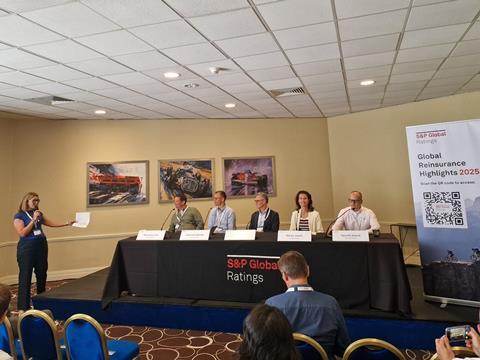S&P observed that the top 19 reinsurers carry 11% capital redundancy, or nearly $40bn. The ratings firm emphasised the reinsurance sector’s strengths, while highlighting uncertainties in casualty, geopolitics and macroeconomic outlook.
S&P Global Ratings used its RVS 2025 press briefing in Monte Carlo to underline the resilience of the reinsurance sector, while cautioning that natural catastrophes, US casualty reserves and geopolitics continue to pose material risks.

Andrea Quirk, global head of credit ratings, opened the session by noting the market’s many headwinds, including trade tariffs, financial market volatility and shifting regulatory pressures.
“We’re seeing a lot of things happening with existing and emerging risks as we move through, and we’re looking at how we tackle all of those credit risks together,” she said.
Economic backdrop
Sylvain Broyer, chief EMEA economist at S&P, set out the macro context. “Despite turbulences, we see the global economy still resilient and adaptive,” he said.
He pointed to relatively low unemployment and strong fiscal stimulus in Europe, but that inflation remains stubborn.
“Every way you look at inflation it is above central bank targets, especially core inflation,” Broyer said.
He noted that the European Central Bank is unlikely to cut rates further, while the US Federal Reserve may ease twice before year-end.
He warned of policy distortions in currency markets and ongoing shocks from US tariffs and geopolitical conflict. “The equilibrium is not stable,” he said. “We have strong distortions and volatility.”
Sector profitability and capital strength
Johannes Bender, director and lead analyst, described the positives supporting S&P’s stable outlook for reinsurers.
“Earnings continue to be strong,” he said. “Our forecast indicates return on equity of 12 to 14% this year and 11 to 13% in 2026, which should cover the sector’s cost of capital.”
Capitalisation has also strengthened, he emphasised.
According to S&P’s model, the top 19 global reinsurers carry an 11% capital redundancy, or nearly $40bn. “That is a significant buffer when you think about stresses,” Bender said.
Discipline at the January 2025 renewals was another factor. “We believe the sector has shown strong resilience and conservatism on terms and conditions,” he said.
Rising cat risk and casualty exposures
Taoufik Gharib, senior director, took the role of highlighting challenges. “The industry continues to be exposed to tail risk,” he said, noting California wildfires earlier this year and the possibility that reinsurers’ share of catastrophe losses could climb back toward 15%.
He also pointed to US casualty reserving. “We don’t think it’s the end of it,” he warned. “Reserves are the gift that keeps giving. Additional reserve development may hit some reinsurers over the next 12 months.”
Geopolitical volatility was another concern. “Both geopolitics and market volatility can create challenges on both sides of the balance sheet,” Gharib said.
Cat bond boom
Maren Josefs, S&P credit analyst, focused on the surge of alternative capital. She reported cat bond issuance of $18bn in the first half of 2025 alone, with total outstanding volume set to exceed $55bn by year-end.
“The alternative capital market is firing on all cylinders,” she said. “Demand for risk transfer is increasing, driven by inflation, urbanisation and climate variability. On the supply side, pricing is still favourable and cat bonds remain the most liquid part of the market.”
Josefs stressed that investors are sophisticated and conduct their own modelling. “The market knows what it is taking on, and is willing to take it for a price,” she said.
Tariffs, aviation and US casualty
In a follow-up Q&A, Broyer said tariffs and geopolitics were weighing on consumer sentiment.
“Households have strong balance sheets, but they can’t see the mood,” he observed. “Uncertainty is causing companies to postpone investment decisions and consumers to save rather than spend.”
Bender noted the Russia–Ukraine conflict’s impact on aviation reinsurance. “That could harden aviation pricing when it renews towards the end of this year,” he said.
US casualty remained the biggest reserving question. Bender estimated adverse development of about $6bn in 2024. “It’s a material part and can bring volatility,” he said, while noting the sector overall still delivered positive run-off results.
Discipline to be tested
Gharib concluded with a reminder that past mistakes should not be repeated. “Yes, the industry had strong performance in 2023 and 2024, but over the last five years it only earned its cost of capital in the last two,” he said.
“Based on our conversations with major players, they seem to be holding firm on attachment points and terms and conditions. Maybe pricing may come down, but for now we expect terms to remain firm,” he added.










No comments yet